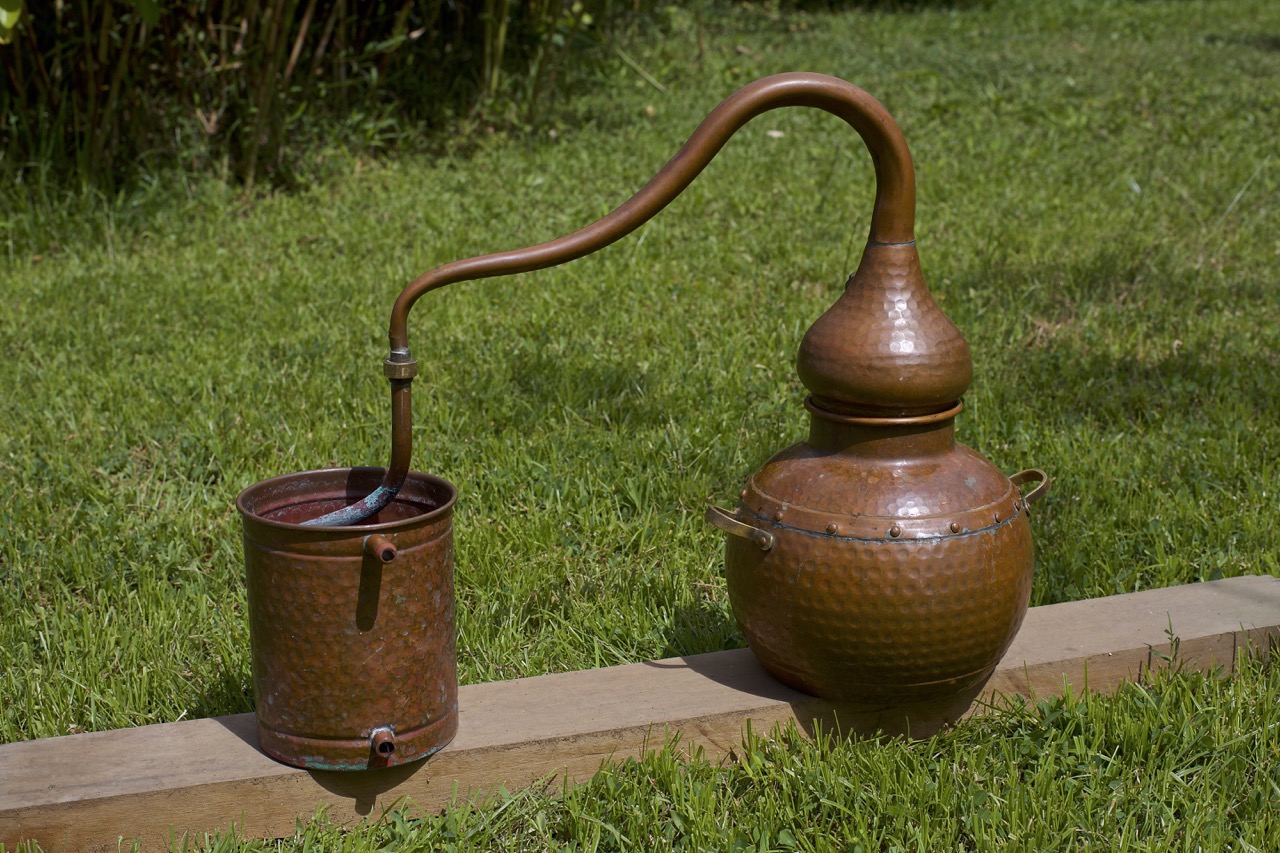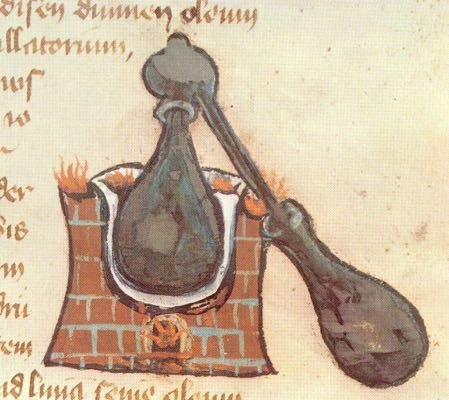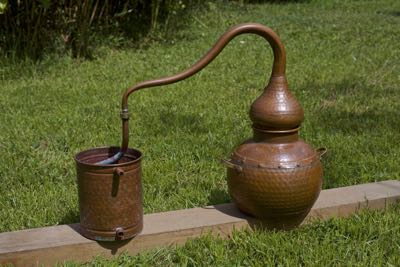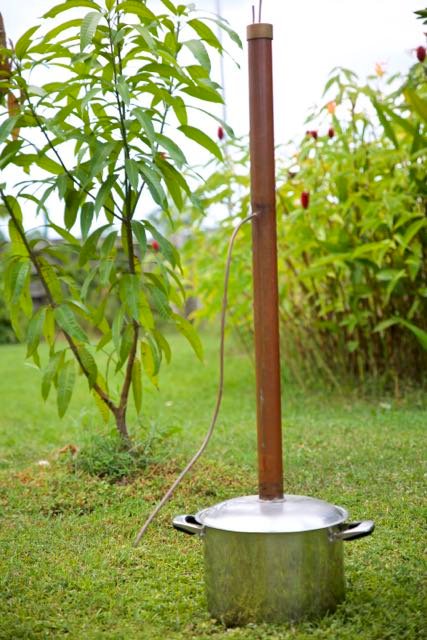Make Your Own Biofuel! - Save Money - Become More Self-sufficient - Why Still?
Stilling ones own alcohol is often frowned upon. Here are a few misunderstandings.
People say it’s illegal.
That’s not true but in most countries you must either get a permit or register your still at the inland revenue. But I’m not a statist so look this one up for your own country.
People say it’s dangerous.
In my years of stilling I never had an accident. I don’t use open fire but an electric hot plate. I don’t recommend using an open fire. Make sure that there’s enough ventilation and you’ll be fine. There might be some danger in making glucose syrup, but I’ll come to that later.
Moonshine is poisonous; you can go blind.
Moonshine is only poisonous when you distill wine or beer or any other kind of fermented fruit or grain and don’t collect and separate the first fraction of your still and throw that away. (Or use it for cleaning windows.)
Plant material contains pectin. When pectin ferments it turns partly into methanol. Because of the lower boiling point of methanol (148.5 F) it will be produced sooner than alcohol which has a higher boiling point (173 F).
I ferment glucose syrup. This doesn’t contain any pectin. By fermenting sugar only ethanol is produced. I still collect the first amount of alcohol and keep it separate because it tastes less.
Stilling is difficult.
No, it’s actually pretty straight forward. Making a really good whisky is difficult. Making moonshine is not.

Why still?
If you like your gin-fizz you will save a lot of money. You save at least 90% compared to the gin bought from the supermarket. Most of that money is taxes which is now not spend by the state on wars overseas. yeah.
You know what you drink. Speaking from personal experience, I never had a hangover drinking my own hooch. How different when indulging one selves with cheap wine or liquor. I’m not advocating drinking but we are all adults here.
Owning a still and knowing how to use one makes you more self-sufficient. Alcohol is a very clean fuel that can run your car or a stove.
Knowing how to produce clean alcohol is important if you want to use it as a solvent. Alcohol as a solvent is used in medicine and to extract essential oils.
You can use your own clean alcohol as a disinfectant.
Use your alcohol for cleaning purposes.
It’s interesting and fun. Knowing how to operate a still can be very rewarding.

First we need to produce some alcoholic drink. So let’s start by making some sugar mash.
Ingredients:
2 kg Sugar
10 L Water
2 gm Citric acid or 20 ml lemon juice
50 gm yeast
First we make glucose syrup. Put the sugar in a sauce pan. Add the citric acid or the lemon juice. Add enough water so that the sugar can dissolve. Put it on the stove and bring it to a boil. During the first 10 minutes keep stirring until the sugar is more or less dissolved. Let it boil for 25 minutes.
Danger: Boiling sugar syrup can cause severe burns. The temperature of the boiling syrup is much higher than that of boiling water and the syrup is extremely sticky. Don’t have any young children or toddlers hanging around your stove.
The citric acid works like a catalyst. The boiling turns sugar into glucose. Glucose ferments much easier than sugar.
Let the syrup cool down. This can take a few hours.
Get a suitable container. This is preferably a glass container with an air lock. I simply use a plastic garbage bin with a plastic lid (the CO2 can still escape through the lid). Clean your container carefully. You don’t want to many bacteria in your sugar mash because this will change it into vinegar. (Not so eco-friendly, but a bit of bleach will kill all the bacteria.)
Fill the container with 10 litres of well aerated water. (Use your shower head.)
Put the yeast in a jug and dissolve it in some lukewarm water. Add a couple of spoons of the glucose syrup and stir this in. This will kick start the yeast into action. Keep an eye on it, it will soon start to overflow.
Add the remaining glucose syrup to the water and add the yeast solution. Stir everything thoroughly, close the container and store it at room temperature. The temperature should be between 16 to 30 degrees celsius.
Stir the mash once a day for the first 5 days. After 5 days to a week it should be ready for stilling. During the fermentation the yeast cells will die off and sink to the bottom. When you’re left with a clear liquid on top of the died off yeast, you’re ready to start stilling.
I use ordinary dry instant yeast. There are lot of different and 'expensive' types of yeast. But cheap instant yeast will work just fine.
Making sugar mash is not an exact science. Little variations in amounts will not make much difference in the end result.
There are two main stills for private use; a pot still or an alembic and a column still.
Using an alembic to produce alcohol.

An alembic consists of three parts. The cucurbit or the main pot containing the liquid. The cap or the head that fits in or over the mouth of the cucurbit to receive the vapours with a down sloping tube that goes to the receiving container. Attached to the down sloping tube is the cooling container. It consists of a container and cooling spiral surrounded by water.
Simply fill the alembic about 4/5 full with the sugar mash.
Connect your hoses to cooling container.
Close the pot with the cap and connect the cooling container.
Put it on a hot plate.
Bring it close to a boil. Try to keep the temperature around 80 to 90 degrees celsius.
Once the first alcohol starts to appear, turn on the water to cool the cooling spiral
The distilling cycle is divided into 4 fractions. The fores, head, heart and tail.
Keep the ‘fores’ separate. It either contains methanol or it simply doesn’t taste that great.
The ‘tail’ is also often discarded because it contains fusel alcohols and they are not so nice either.
The hearts is the most desirable component. And your nose is your best guide to obtain it.
The sugar mash contains somewhere between 12 and 18 % ABV.
After stilling with an alembic the percentage is around 50 to 55 % ABV.
Your collected liquor is now ready for redistilling, ‘washing’ the alcohol and producing your gin.
Wash out your alembic.
Fill the alembic with your collected liquor and add at least an equal amount of clean water. This will ‘wash’ your alcohol.
Add some lemon zest. (1 or 2 teaspoons for 0,5 litre liquor)
Repeat the stilling process
You can add other spices or herbs of course and create your own masterpiece.
The lemon zest is the most important one to make it into a nice gin.
After the second distill run, the percentage will be around 80 % ABV.
Add water so the percentage drops to 35 % ABV and you just produced your own gin.
Some people redistill 3 or even more times. I often distill only ones and simply add the lemon zest to the sugar mash just before stilling.
It’s handy to have an alcohol meter and a thermometer. But mine all broke so I just use my nose and my experience.
A copper alembic doesn’t produce high percentages of alcohol that easily and is therefore not really suited for fuel production. A column still can produce up to 95 % ABV in one run.

In the next episode I’ll be discussing a column still and how to build your own as I did myself for less than 75 SBD.
Cheers and much love,
Gardenbsquared

That's such a cool informative post and lol as i thought it would be about biofuel to run your old diesel vehicle on, something i was busy with a long, long time ago.
Will have a better look at it at home, currently on the road, to see if i can find some suitable pot for it. Resteemed.
Thank you. Alcohol is a biofuel of course. But you must have a bigger still to run your car. Copper is always best or stainless steel. Cheers!
Have you ever come across David Blume's Book "Alcohol can be a gas' ??? I got to hear his lecture at a Festival in Hopland CA some years ago... The thing he said that always stayed with me was: "The United States demand for fuel can be met by grass clippings'" meaning cellulosic ethanol could be used to make all the ethanol the US needs for transport. Amazing. Great Post, look forward to the next one!
One of the other uses for high grade alcohol that might not have been mentioned is as a solvent for tinctures. I am hoping to promote skills like these (will resteem on @ecoknowme) as well as plant based medicines... which might need alcohol to extract specific medicinal compounds. One thing you could try after you make your moonshine is to put a few handfuls of sliced Reishi mushroom (or something that has the properties your body might benefit from).
Here is an article I wrote about my idea to promote and propagate our own medicines within the Steemit Community itself:
https://steemit.com/gardening/@ecoknowme/steemit-community-do-you-garden-help-the-ecoknowme-help-you-help-others-while-growing-your-own-medicine-business
Maybe a new era of home brews will be coming thanks to you! Really nice post @gardenbsquared
My son wants to make his own still too. That looks like a simple one. Upvoting and following.
Thanks for writing this excellent instructive, practical article. I've always wanted to make my own moonshine, but was afraid of going blind. I'm going to resteem this so I can use it for reference when the time comes for me to live up to my name and build my own still.
You're welcome. In my next article about stilling I'll explain how I build my own. It's not perfect but I can share my mistakes and what I've learned. Thanks.
I don´t drink alcohol, but I like people brewing their own beer, stilling or making wine of their own, as I regard that as an important cultural technique and it is good to have some diversity in that field too and not leave everything to centralised multinational corporations.
Could not agree more. It feels great to have build my own still and know how to work it. Thanks.
Very interesting. I need to look into this as clean fuel. I have had many old mercedes I got just for running biofuel in. I would go get all the yucky old cooking oil I could find to make it and ran over 200K miles on it. That only works on diesels with some modifications. Now I have a mini van. I am definitely going to pick your brain on this more if you don't mind. I don't drink myself only because my body just doesn't deal with it well. I have no tolerance I guess. I always gravitated to the herb.
Anyway good stuff DIY is the way!!
Thank you. My understanding about stilling is basic but I'm more than happy to share whatever I know.
thanks for sharing that post ! resteem ..
Inspiring article! Upvoted!
Very interesting, commenting so I can come back to this when I get home tonight.
Hey @gardenbsquared, I liked your post so much I included it in my Look What I Found! curation series. Take a look: https://steemit.com/curating/@stortebeker/old-school-style-beekeeping-alcohol-distilling-and-discovering-the-herbalist-within